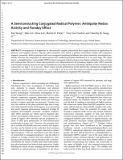A Semiconducting Conjugated Radical Polymer: Ambipolar Redox Activity and Faraday Effect
Author(s)
Wang, Pan; Lin, Sibo; Lin, Zhou; Peeks, Martin D; Van Voorhis, Troy; Swager, Timothy M; ... Show more Show less
DownloadAccepted version (1.139Mb)
Publisher Policy
Publisher Policy
Article is made available in accordance with the publisher's policy and may be subject to US copyright law. Please refer to the publisher's site for terms of use.
Terms of use
Metadata
Show full item recordAbstract
Investigations of magnetism in electronically coupled polyradicals have largely focused on applications in photonic and magnetic devices, wherein radical polymers were found to possess molecularly tunable and cooperative magnetic properties. Radical polymers with nonconjugated insulating backbones have been intensively investigated previously; however the integration of radical species into conducting polymer backbones is at an early stage. We report herein 1,3-bisdiphenylene-2-phenylallyl (BDPA)-based conjugated radical polymers that display ambipolar redox activities and conductivities. Moreover, these radical polymers were demonstrated to be promising magneto-optic (MO) materials with Faraday rotations wherein the sign is modulated by the radical character and display absolute Verdet constants up to (2.80 ± 0.84) × 104 deg T-1 m-1 at 532 nm. These values rival the performance of the present-day commercial inorganic MO materials (e.g., terbium gallium garnet, V = -1.0 × 104 deg T-1 m-1 at 532 nm). The structure property studies detailed herein reveal the promise of multifunctional conjugated radical polymers as responsive MO materials.
Date issued
2018-08Department
Massachusetts Institute of Technology. Department of Chemistry; Massachusetts Institute of Technology. Institute for Soldier NanotechnologiesJournal
Journal of the American Chemical Society
Publisher
American Chemical Society (ACS)
Citation
Wang, Pan et al. "A Semiconducting Conjugated Radical Polymer: Ambipolar Redox Activity and Faraday Effect." Journal of the American Chemical Society 140, 34 (August 2018): 10881–10889 © 2018 American Chemical Society
Version: Author's final manuscript
ISSN
0002-7863
1520-5126